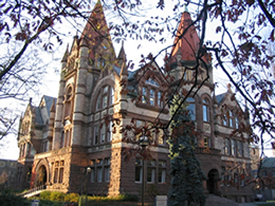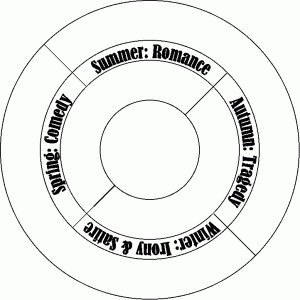
Responding to Russell Perkin:
In the Prologue to his 1949 diary, Frye writes, “I’m beginning to feel a bit restless—impatient with Victoria’s corniness, & wondering if it is really the best place in the world to work” (Diaries, 53) Then there are these entries:
The English department [at Michigan State] however lives in a squalor that reminded me of Victoria College. (Diaries, 193––26 April 1949)
Well, well. On the way back Woodhouse told me Don Cameron Allen of Johns Hopkins had written him asking him if he thought anyone in Canada was capable of filling a full professorship there: 19th c. preferred, but failing that, history of criticism & general problems. At the end of his letter he said “What about Frye?” I said “please don’t slam that door.” Salary $7000, leading (they don’t say how soon) to $8000. (Diaries, 231––16 January 1950)
At the moment, of course, I feel dreadfully bored because two things dangling in front of me all month like the apples of Tantalus haven’t moved any closer. One is the Johns Hopkins offer, the other the English invitation [NF had been invited by Bonamy Dobrée to lecture in England]. I’ve more or less written off the former, & the latter is fading. Then again, by not applying for the Nuffield I’ve stuck my neck out on the Guggenheim, & if I miss it I’ve really had it. Oh, well, I suppose I should set all this down, as I have at least another month of it to go through. More important is my recurring restlessness about Victoria, wondering if they’ll really adopt [Walter T.] Brown’s policy of running it at a third-rate level. If so, I must make up my mind to leave, & that won’t be easy. As I’ve said, I don’t think much of Joe as the next head, but he couldn’t be much worse than Robins has been lately. Well, that’s enough ego-squalling for the present. Light—I mean Lead, kindly Light, amid the encircling gloom. I don’t care about choosing my path, but I’d like to get a glimpse of it occasionally. (Diaries, 242––27 January 1950)
After the usual buggering I went into lunch with the males in the English department, Cecil Bald, & Bennett. I had mildly suggested moving the party to Chez Paris [Paree], in view of the fact that Bald has a special interest in Coleridge & it was silly to leave Kay Coburn out. Robins said he couldn’t make the switch because Bennett didn’t want to take the party “off the campus.” [NF had suggested that the group have lunch “off the campus” so that Kathleen Coburn could be included in the party. Women were excluded from eating in the Senior Common Room until 1968] That’s the kind of thing that makes me restless about staying at Victoria. (Diaries, 248–9––3 February 1950)

